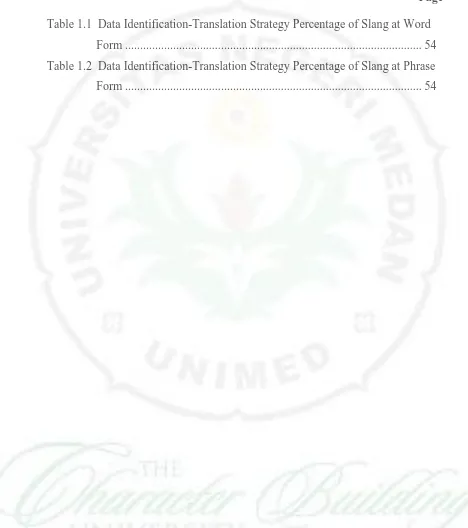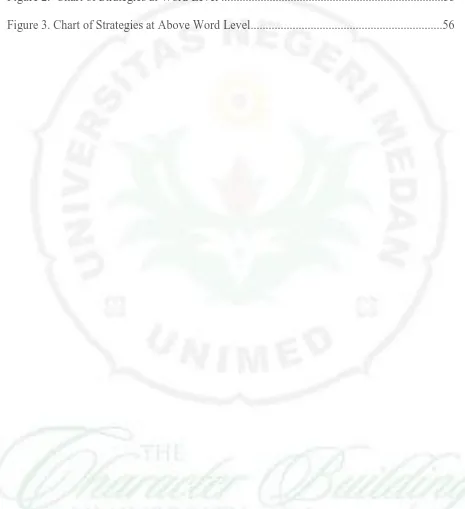EQUIVALENCE STRATEGIES IN THE TRANSLATION OF ENGLISH SLANGS INTO BAHASA INDONESIA
A Thesis
Submitted to English Applied Linguistics Study Program in Partial Fulfillment of the Requirements for the Degree of
Magister Humaniora
By
DHARMA YUNITA SIREGAR Registration Number :8146111015
ENGLISH APPLIED LINGUISTICS STUDY PROGRAM POSTGRADUATE SCHOOL
i ABSTRACT
S, Dharma Yunita. 2016. Equivalence Strategies in The Translation of English Slangs into bahasa Indonesia. English Applied Linguistic Study Program. Postgraduate School. State University of Medan. 2016.
Key Words: equivalence strategies, translation, slang.
i ABSTRAK
S, Dharma Yunita. 2016. Strategi Kesetaraan di dalam Penerjemahan bahasa slang Inggris ke dalam bahasa Indonesia. Program Studi Linguistik Terapan Bahasa Inggris. Sekolah Pascasarjana Unimed Medan. 2016.
Key Words: strategi kesetaraan, terjemahan, slang.
iii
ACKNOWLEDGEMENTS
Bismillahirahmanirahim,
Praises be to Allah SWT for His Great Blessing, Health and Luck that have been continuously poured to the writer in the process of completing her studies and this piece of academic writing. Praises are also addressed to our Prophet Muhammad SAW who has guided us to the better life of today. In the process of completing this thesis, the writer has to confess her profound thankfulness for the generous guidance and assistance which has been rendered to her by many people. It would be impossible to list all names but on this very special opportunity the writer would like to express her gratitude to the following people.
First of all, the writer deepest appreciation and gratitude is dedicated to Dr. Syahron Lubis, M.A., her first adviser for the guidance, comments, criticisms, encouragement, suggestions and special notes for the improvement of the thesis from the very beginning up to the end of this thesis.
Next, her deepest appreciation is addressed to Dr. Zainuddin, M.Hum., her second adviser for his available time spent for consultation, comment, notes for improvement of the thesis, and full support in shaping this thesis.
iv
She would like to express her thanks to all lecturers who have given the valuable knowledge and the excellent performance in delivering the lectures during her study at the English Applied Linguistics Study.
Thanks also to her reviewers and examiners, Prof. Amrin Saragih, M.A.,Ph.D., Prof. Dr.Sri MindaMurni, M.S., and Dr. Rahmad Husein, M. Ed for their valuable inputs to be included in this thesis.
The writer endless gratitude should also go to her beloved parents, Syahrir Siregar, and Kasamria L. Tobing, S.Pd., together with her lovely brother andsister, thanks for the best thing that you have given for me: your encouragement, your patience, your struggel and also your love, her lovely someone, who have patiently given moral and support their never ending love and pray.She also would like to express her thankfulness for her friends in class A3 LTBI for the support and help to finish this thesis and all people who gave me help, spirit, support, and love that I can not mentionone by one
Medan, Juni 2016 The writer,
Dharma Yunita Siregar
vii
TABLE OF CONTENTS
ABSTRACT ... i
ABSTRAK ... ii
ACKNOWLEDGEMENTS ... iii
TABLE OF CONTENTS ... v
LIST OF TABLES ... viii
LIST OF FIGURES ... ix
LIST OF APPENDICES ... x
CHAPTER I INTRODUCTION ... 1
1.1. Background of the Study ... 1
1.2. The Problems of the Study ... 8
1.3. The Objectives of the Study ... 9
1.4. The Scope of the Study ... 9
1.5. The Significance of the Study ... 9
CHAPTER II REVIEW OF LITERATURE ... 11
2.1. Translation ... 11
2.2. Translation as Product and Process ... 12
2.3. Types of Translation ... 14
2.4. Method of Translation ... 16
2.5. Equivalence ... 18
2.6. Kinds of Equivalence ... ..20
2.7. Equivalence Translation Strategies ... 26
2.7.1. Equivalence Translation Strategies at Word Level ... 26
2.7.2. Equivalence Translation Strategies at Above Word Level ... 31
2.8. Slang ... 33
2.8.1. Slang Form ... 34
2.8.2. The Charateristics of Slang ... 36
2.9. The Translation of Short Story/Novel ... 37
2.10. Previous Relevant Study ... 37
2.11. Conceptual Framework ... 41
vii
3.1. Research Design ... 43
3.2. The Data and Data Source ... 44
3.3. Data Collection ... 44
3.4. Technique of Data Collection ... 44
3.5. Data Analysis ... 45
3.6. Trustworthiness of the Study ... 46
3.6.1. Credibility ... 47
3.6.2. Transferability ... 47
3.6.3. Dependability ... 47
3.6.4. Confirmability ... 47
CHAPTER IV DATA ANALYSIS, FINDINGS AND DISCUSSIONS ... 49
4.1 Data Analysis ... 49
4.1.1 The Strategies used in Translating the Slang Word into bahasa Indonesia ... 57
4.1.1.1. Translation by a more general word ... 57
4.1.1.2. Translation by a more neutral/less expressive ... 58
4.1.1.3. Translation by cultural substitution ... 59
4.1.1.4. Translation by using loan word or loan word plus explanation...59
4.1.1.5. Translation by paraphrase using a related word ...60
4.1.1.6. Translation by paraphrase using unrelated word ...60
4.1.1.7. Translation by omission... 61
4.1.2 The Strategies used in translating the slang phrase into bahasa Indonesia... 62
4.1.2.1. Translation by similar meaning and form ...62
4.1.2.2. Translation by similar meaning but dissimilar form ...62
4.1.2.3. Translation by paraphrase ... 63
4.1.2.4. Translation by omission... 64
4.1.2.5. Translation by addition ... 65
4.1.3 The most dominant strategy and the least used in translating english slang into bahasa Indonesia... 65
vii
4.3 Discussions ... 68
CHAPTER V CONCLUSIONS AND SUGGESTIONS ... 71
5.1 Conclusions ... 71
5.2 Suggestions ... 72
REFERENCES ... 74
vii
LIST OF TABLES
[image:12.595.67.535.121.649.2]Page Table 1.1 Data Identification-Translation Strategy Percentage of Slang at Word
viii
LIST OF FIGURES
[image:13.595.65.530.137.646.2]ix
LIST OF APPENDICES
1
CHAPTER V
CONCLUSIONS AND SUGGESTIONS
5.1. Conclusion
1. Based on the data analysis, research findings and discussion, there were six types of strategies used at word level in translating the slang word into bahasa Indonesia. They were (1) Translation by a more general word (2) Translation by a more neutral/less expressive (3) Translation by a loan word or loan word plus explanation (4) Translation by paraphrase using a related word (5) Translation by paraphrase using unrelated word (6) Translation by omission.
2. To answer the second question of the research problem, based on the analysis the researcher found all the strategies used at above word level in this analysis based on the theory of Baker, they are (1) Translation by similar meaning and form (2) Translation by similar meaning but dissimilar form (3) Translation by paraphrase (4) Translation by omission(5) Translation by addition.There was strategies not in line with the theory of Baker (1992) namely translation by addition at above word level.
2
level (for slang in word form), The researcher found slang words was translated dominantly by using a more general word at word level with 43 cases (48.31%) where when the target language does not have specific term that is the same as source language,a translator can use a more general word in the target language that has the core propositional meaning of a specific word in the source text and 2) equivalence translation strategies at above word level (for slang in phrase form) with slang phrases was dominantly translated by using similar meaning and form since it has 11 cases (55%) in the translation. Because it’s a kind of matching idiom from the target language with idiom from the source language so that the translator can apply this strategy to make the meaning is clear. Translation by addition as the finding of this study. Finally, the researcher concluded that Luci Dokubani as the translator of The ABC Murders was translated slang words by using general words and slang phrases with similar meaning and form.
5.2.Suggestions
Slang is an interesting term to translate. Beside it has different meaning in
its words, slang is one of the language phenomenon that we usually find in our
daily activities. Understanding slang is not as easy as it seems because some
3
translation from the method or another translation procedures that were offered by several translation linguists.There are other methods or procedures of translation which can be analyzed from the data or another data of slang. Observing other slang in other text is also suggested. For instance, observing the slang occurred in comics and movies. This research also has possibility to be analyzed through the ideology of a translator in doing slang translation.
REFERENCES
Adams, M. 2009. Slang – the People’s Poetry. Indianapolis, Indiana: Oxford Press.
Alwasilah, A., C. 1985. Sosiologi Bahasa. Bandung: Angkasa Bandung.
Azwar, S .2004. Metode Penelitian. Yogyakarta : Pustaka Pelajar
Baker, M. 1992. In Other Words: A Coursebook on Translation. London: Sage Publication.
Baker, M. ed. 2001. Routledge Encyclopedia of Translation Studies. London: Routledge.
Bernard, S. 1998. Sociolinguistics.New York: Oxford University Press
Bogdan, R and Biklen, SK. 1992. Qualitative Research for Education: An Introduction to Theory and
Methods. Boston: Allyn and Bacon.
Catford, J.C. 1965. A Linguistic Theory of Translation. London: Oxford University Press.
Choliludin. 2005. The Technique of Making Idiomatic Translation. Bekasi: Visipiro-Kesaint Blanc.
Glewwe, E. 2012. Translating French Slang: A Study of Four French Novels and Their English Translations. Department of Linguistics Swarthmore College.
Hornby, A. S. 1995. Oxford Advances Learner’s Dictionary. London: Oxford University Press.
Idris, M. 2012. An Analysis Of Equivalence Of Cultural Terms In Some Cultural Articles In Indonesia’s Official Tourism Website. Medan: English Department Faculty of Cultural Studies University of Sumatera Utara.
Katan, D. 1999. Translating Cultures: An Introduction for Translator, Interpreters, and Mediators. Manchester: St. Jerome Publishing.
Larson, M. 1984. Meaning Based Translation. USA: University Press of America, Inc.
Lincoln, Y. S. & Guba, E. G. 1985. Naturalistic Inquiry. Baverly Hills: CA Sage Publications.
Machali, R. 2000. Pedoman Bagi Penerjemah. Jakarta: Grasindo.
Masshady, H. And Pourgalavy, M. 2013. Slang Translation: A Comparative Study of J.D Salinger’s
The Catcher in The Rye. Finlad: Academy Publisher.
Mattielo, E. 2005. The Pervasveness Slang. UK : Mots Palabras Words.
Montague, R. 1973. The Proper Treatment of Quantification in Ordinary English. In Approaches to
Natural Language, eds. K.J.J. Hintikka, J.M.E. Moravcsik and P. Suppes, 221-242.
Munday, J. 2001. Introducing Translation Studies. London: Routledge.
Nababan, M.. 2003. Teori Penerjemah Bahasa Inggris Yogyakarta: Pustaka Palajar.
Newmark, P. 1988. A Textbook of Translation. New York: Prentice Hall International.
Nida, E. A., & Taber, C. R. 1974. The Theory and Practice of Translation. Leiden: E.J. Brill.
Schjoldager, A. 2008. Understanding Translation. Aarhus: Academica.
Septiani. 2013. Equivalence Strategy Used in Translating The Hunger Games Novel Into Indonesian. School of Teacher Training of Education, Muhammadiyah University of Surakarta.
Simatupang, M. 2000. Pengantar Teori Terjemahan. Jakarta: Universitas Indonesia.
Subroto, E. 2007. Pengantar Metode Penelitian Linguistik Struktural. Surakarta, Universitas Sebelas Maret.
Suryawinata, Z. 1989. Terjemahan: Pengantar Teori dan Praktek. Jakarta: Departemen Pendidikan
dan Kebudayaan Direktorat Jendral Pendidikan Tinggi Proyek Pengembangan Lembaga
Pendidikan Tenaga Kependidikan.
Sutopo, HB. 2006, Metode Penelitian Kualitatif, Surakarta: UNS Press.
Thorne, T. 2005. Dictionary of Contemporary Slang. London: A & C Black Publishers Ltd.
Venuti, L. 2000. The Translation Studies Reader. London: Routledge.
Webster's Merriam Dictionary, © 2011, Merriam-Webster, Inc.
. December 2010. Slang. Retrieved from:
http://www.answers.com/topic/slang#ixzz1kfru8td1/Fowler's Modern English Usage: slang (November 2015)
1993-1996 “Slang”. Microsoft Encarta 97 Encyclopedia CD-ROM Microsoft Urban Dictionary. Retrieved from http://Urbandictionary.com (Maret 2012)
2006.1990’s Slang. Retrieved from http://www.host-party.com/files/hp_1990s_Slang.pdf (7
November 2015)
Widyanto, A. 2013. An Analysis on Slang in The Script of 8-Mile Film: A Sociolinguistic Approach. School Of Teacher Training And EducationMuhammadiyah University Of Surakarta.

